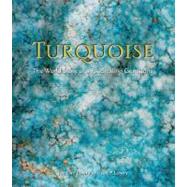
| Preface | p. 6 |
| Acknowledgments | p. 8 |
| Introduction | p. 10 |
| Knowing the Mystical Qualities of Turquoise | p. 19 |
| Learning the International History of Turquoise | p. 43 |
| Studying the Geology and Mineralogy of Turquoise | p. 103 |
| Mining Turquoise | p. 121 |
| Cutting Turquoise-Lapidary Work | p. 149 |
| Grading and Caring for Turquoise | p. 175 |
| Identifying Turquoise Imitations | p. 193 |
| Mapping Classic Turquoise Mines | p. 217 |
| Map: Turquoise Mines of the Southwest | p. 248 |
| Endnotes | p. 249 |
| Bibliography | p. 250 |
| Index | p. 252 |
| Credits | p. 256 |
| Table of Contents provided by Publisher. All Rights Reserved. |
The New copy of this book will include any supplemental materials advertised. Please check the title of the book to determine if it should include any access cards, study guides, lab manuals, CDs, etc.
The Used, Rental and eBook copies of this book are not guaranteed to include any supplemental materials. Typically, only the book itself is included. This is true even if the title states it includes any access cards, study guides, lab manuals, CDs, etc.
Colors in Architecture and Art The color turquoise has been used in architecture and ornamentation throughout history. For example, when bricks were invented for building materials, a glaze was added to the backed earthenware to add hardness to the surface and color for beauty. Faience was particular glazed earthenware that was made and used in Babylon, Egypt, and elsewhere. It was given an opaque glazed finish that included a variety of blue colors. Later, the same faience methods were used to create beads in various shapes that were fashioned, drilled, and strung for personal adornment. The invention of glass from sand (silica), lime, and soda developed another new type of ware and personal adornment. Colored glass was in great demand, and turquoise blue colors were some of the colors used. Glass has been used for its own beauty and as a substitute for many of the colored gemstones in ancient days as well as in modern times. Trade routes became important pathways for cultures to exchange items and become more interrelated. The British Museum displays a colored-glass necklace that was traded from China through Siberia to the Hokkaido Ainu culture of Japan. This was a very long way to travel; it went through several cultures, but it was a very beautiful addition to the final purchaser. In the other exhibit, a small handful of beads are displayed that were found in an early predynastic Badarian burial site in Upper Egypt, dated to the fifth millennium BC. They are roughly shaped beads of carnelian, agate, serpentine, and one bead of turquoise. In modern times, the art of the famous Murano glass and glassblowers in Venice, Italy, and the glass bead makers of Czechoslovakia are still sought and traded around the world.